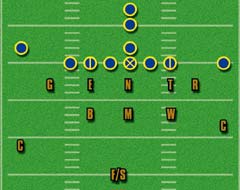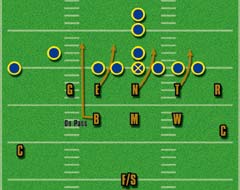G
Guest
I wonder what would you guys do? To stop the run this week?
I myself would run a modern 4-6 at least stack 8 in the box, or a 5-2? instead a 3-5 put the corners on islands and make the QB and wideout beat us. Instead of D-mac?
So what would you do?
Our base defense is a 3-3-5 - three down linemen, three linebackers and five defensive backs. We are a field-call defense, in that we will primarily declare strength to the field. Our end, Bandit linebacker, Gator and field corner line up to the field while our tackle, Willie linebacker, Rover and boundary corner line up to the boundary

The three linebackers stack behind our D-linemen and the strong safeties (Gator and Rover) will align anywhere from on the line of scrimmage to 5-yards deep, and 2-3 yards outside the tight end or the tackle on an open end side. We give our three linebackers and our five defensive backs tremendous freedom to move pre-snap. We want to sell the possibility of the blitz on every play.
Our base alignment for our three down linemen is a heads up alignment. From this alignment, we use a variety of charges/movements. If the call is BASE, we want all three D-linemen to explode off the ball and knock the lineman in front of them into the backfield. If the O-lineman moves laterally, we will bend and pursue as flat as possible given the aggressiveness of the charge.

Eight in the box
The area occupied by defensive linemen and linebackers is often referred to as "the box." The box is usually about 3-5 yards in depth and spans the offensive line in width. Normally seven players occupy this area but frequently another player is brought into the box for run support against smashmouth-oriented offensive teams or short yardage situations. The most common occurrence of eight in the box in the NFL involves the strong safety walking down from his position 10-15 yards off the line of scrimmage before the ball is snapped. From this tightened position he can offer the aforementioned run support as well as jam WRs and TEs, blitz the QB, or provide flat coverage. Due to the superior athleticism of NFL players, it is not uncommon for the box safety to even provide deep coverage after the snap, giving the QB a pre-snap Cover 1 read but effectively transitioning into Cover 2 or another shell post snap.
46 defense
A variation of "8 in the box" is called the 46 or "Bear" defense. It is designed to put pressure on the QB by lining up the defense with 3 defensive linemen covering the center & guards, and the 4th defensive linemen lined up either "wide" outside the TE or wide off the weak-side Tackle. The linebackers & strong safety are lined up behind the defensive line to put pressure on the QB as well.
The name "46" originally came from the jersey number of Doug Plank, who was a starting safety for the Chicago Bears when Bears' defensive coordinator Buddy Ryan originally developed the defense, and typically played in that formation as a surrogate linebacker. It also refers to the idea that the cornerbacks often play bump and run coverage and blitz, acting almost like two extra linebackers.
The key feature of the "46" is that both outside linebackers play on the same side of the formation. The linebackers line up behind the linemen two or three yards from the line of scrimmage. The primary tactic is to rush five to eight players on each play, either to get to the quarterback quickly or disrupt running plays.

I myself would run a modern 4-6 at least stack 8 in the box, or a 5-2? instead a 3-5 put the corners on islands and make the QB and wideout beat us. Instead of D-mac?
So what would you do?
Our base defense is a 3-3-5 - three down linemen, three linebackers and five defensive backs. We are a field-call defense, in that we will primarily declare strength to the field. Our end, Bandit linebacker, Gator and field corner line up to the field while our tackle, Willie linebacker, Rover and boundary corner line up to the boundary

The three linebackers stack behind our D-linemen and the strong safeties (Gator and Rover) will align anywhere from on the line of scrimmage to 5-yards deep, and 2-3 yards outside the tight end or the tackle on an open end side. We give our three linebackers and our five defensive backs tremendous freedom to move pre-snap. We want to sell the possibility of the blitz on every play.
Our base alignment for our three down linemen is a heads up alignment. From this alignment, we use a variety of charges/movements. If the call is BASE, we want all three D-linemen to explode off the ball and knock the lineman in front of them into the backfield. If the O-lineman moves laterally, we will bend and pursue as flat as possible given the aggressiveness of the charge.

Eight in the box
The area occupied by defensive linemen and linebackers is often referred to as "the box." The box is usually about 3-5 yards in depth and spans the offensive line in width. Normally seven players occupy this area but frequently another player is brought into the box for run support against smashmouth-oriented offensive teams or short yardage situations. The most common occurrence of eight in the box in the NFL involves the strong safety walking down from his position 10-15 yards off the line of scrimmage before the ball is snapped. From this tightened position he can offer the aforementioned run support as well as jam WRs and TEs, blitz the QB, or provide flat coverage. Due to the superior athleticism of NFL players, it is not uncommon for the box safety to even provide deep coverage after the snap, giving the QB a pre-snap Cover 1 read but effectively transitioning into Cover 2 or another shell post snap.
46 defense
A variation of "8 in the box" is called the 46 or "Bear" defense. It is designed to put pressure on the QB by lining up the defense with 3 defensive linemen covering the center & guards, and the 4th defensive linemen lined up either "wide" outside the TE or wide off the weak-side Tackle. The linebackers & strong safety are lined up behind the defensive line to put pressure on the QB as well.
The name "46" originally came from the jersey number of Doug Plank, who was a starting safety for the Chicago Bears when Bears' defensive coordinator Buddy Ryan originally developed the defense, and typically played in that formation as a surrogate linebacker. It also refers to the idea that the cornerbacks often play bump and run coverage and blitz, acting almost like two extra linebackers.
The key feature of the "46" is that both outside linebackers play on the same side of the formation. The linebackers line up behind the linemen two or three yards from the line of scrimmage. The primary tactic is to rush five to eight players on each play, either to get to the quarterback quickly or disrupt running plays.


